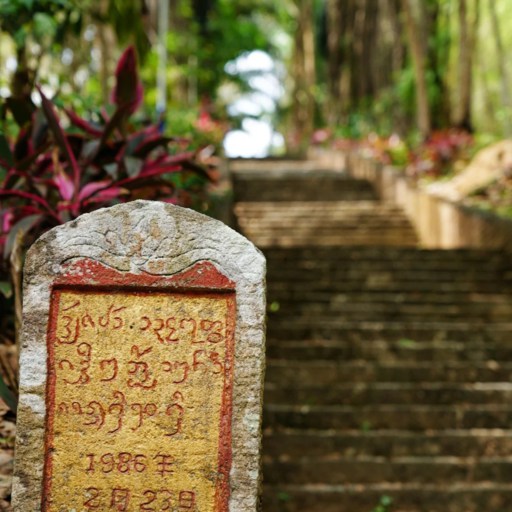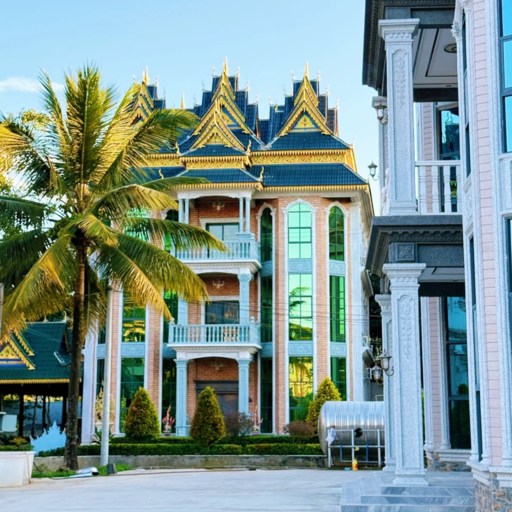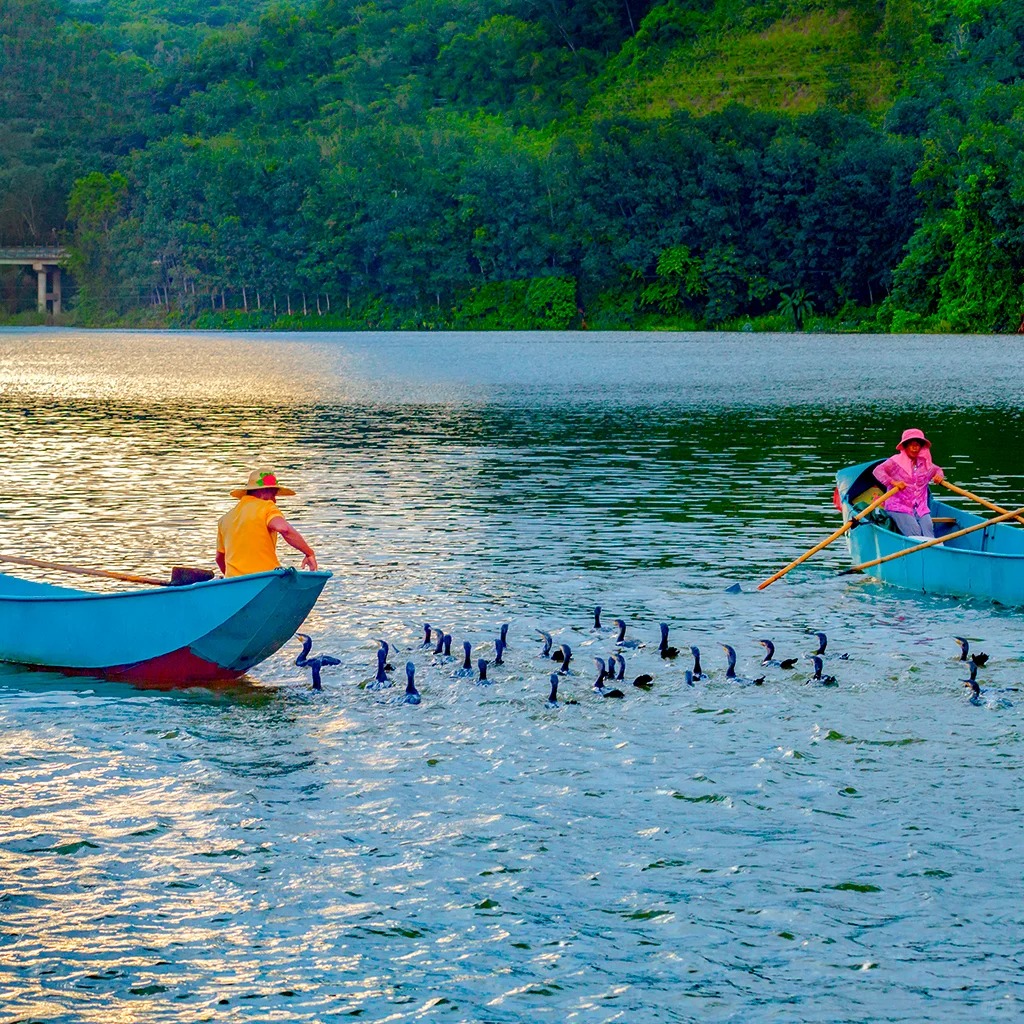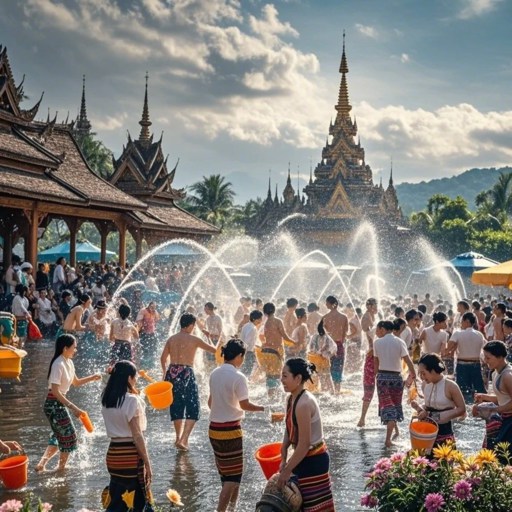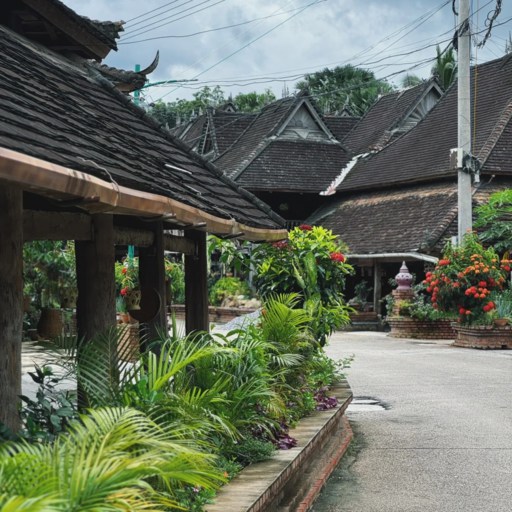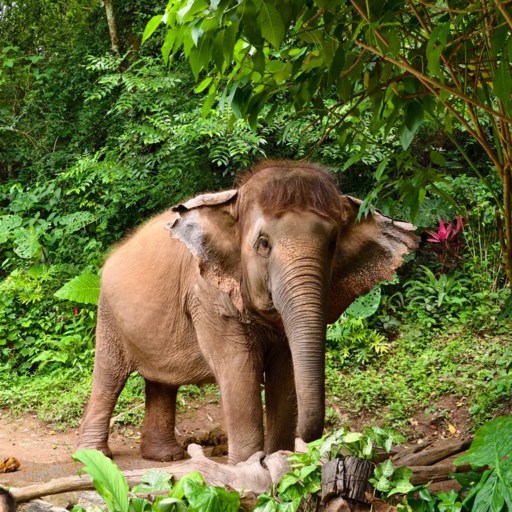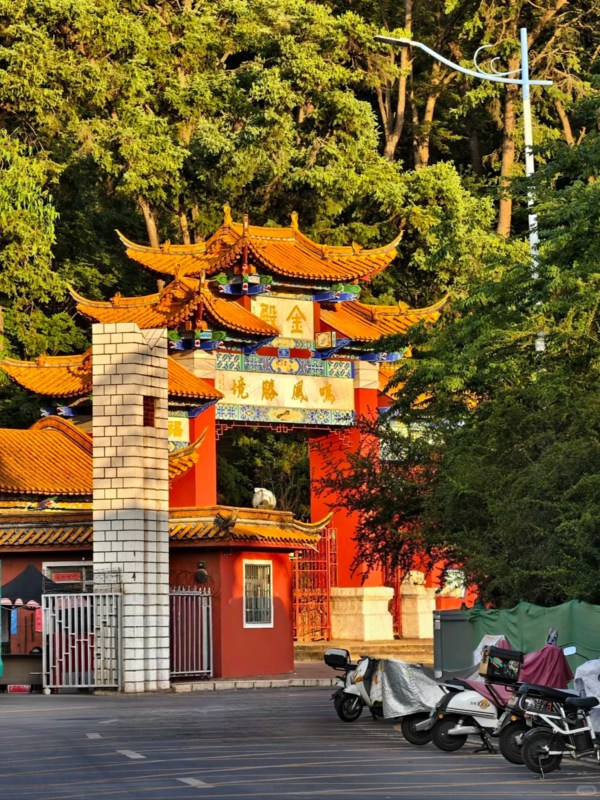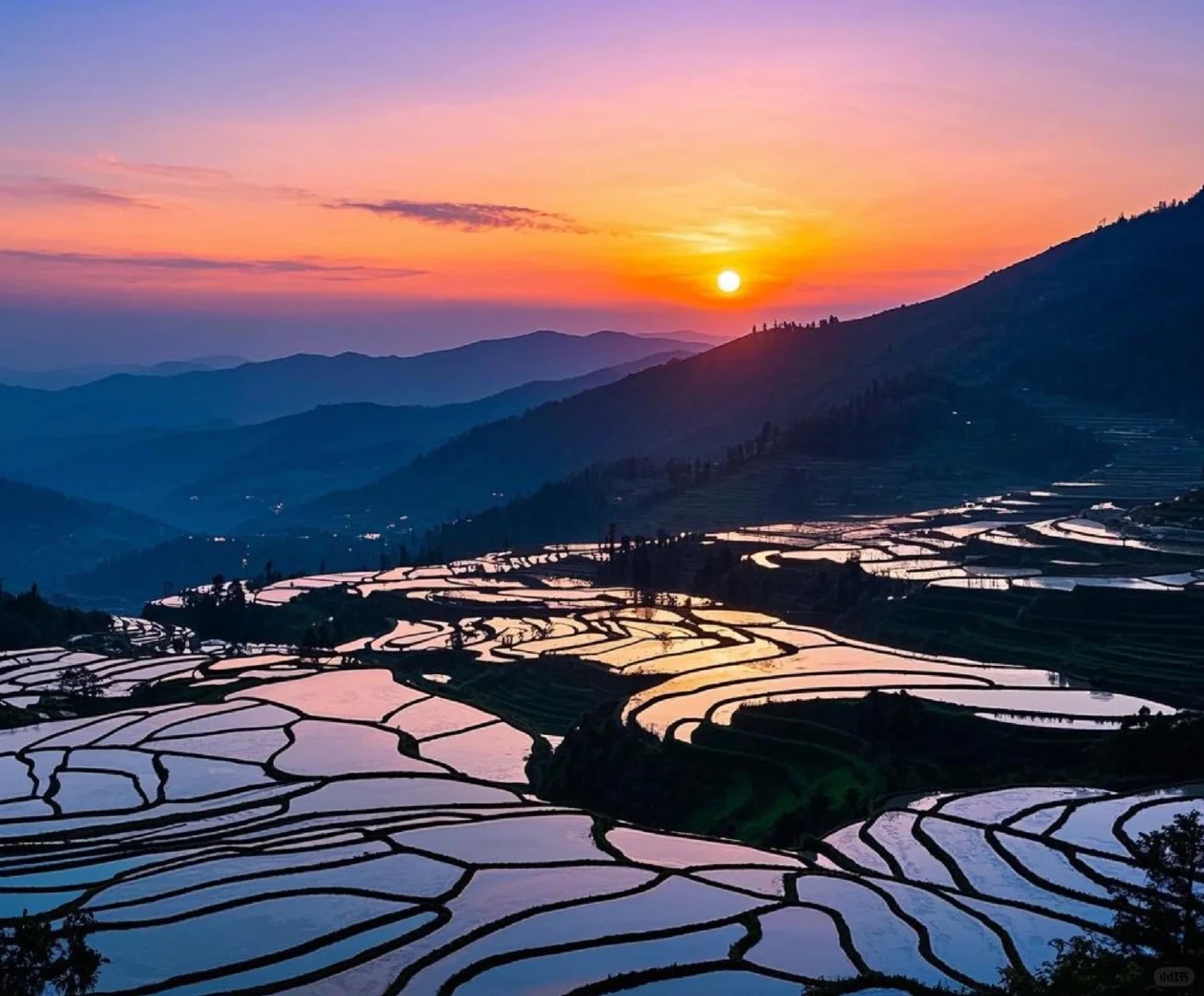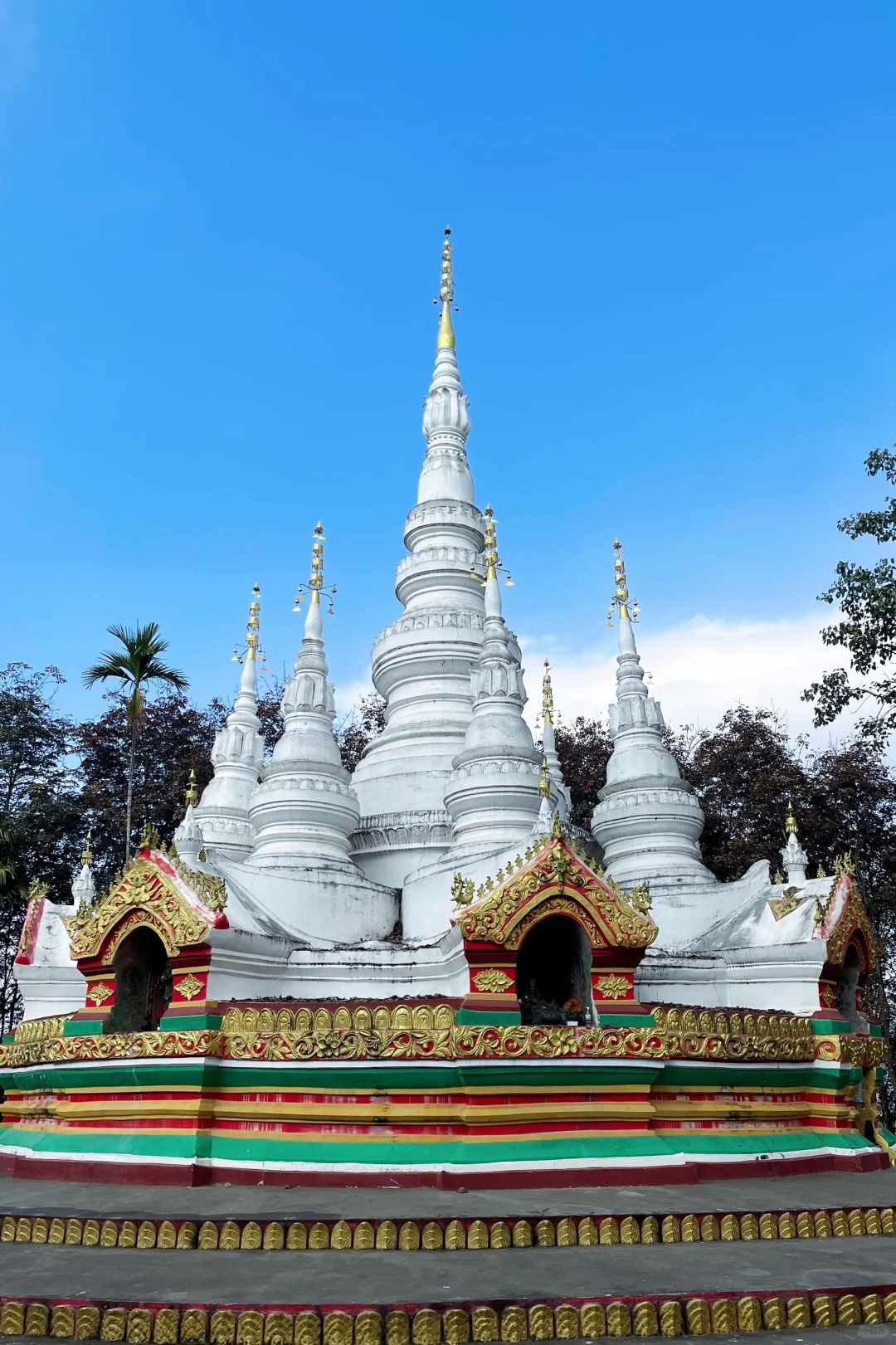
Manfeilong White Pagoda
The Manfeilong White Pagoda isn’t what you expect when driving near Damenglong. At first, it looks like a pale monument rising quietly behind banana trees, nine slender white towers piercing through the green. As you walk closer, it begins to feel alive. The main pagoda stands like a tall candle in the center, surrounded by eight smaller ones that catch and scatter Yunnan’s sunlight. Children from the nearby Dai village sometimes play along the steps, their laughter echoing off the stone. Now and then, you’ll see an old man lighting incense, half smiling — not for tourists, but for the Buddha himself.
The climb (around 200 steps) will make you sweaty and happy. Don’t bring expectations, bring water. It is a location that favors inquisitiveness over photos.
Quick Facts about the Manfeilong White Pagoda
| Chinese Name | 曼飞龙白塔 |
| Location | Manfeilong Village, Damenglong Town, Jinghong City, Xishuangbanna, Yunnan |
| Built In | 1204 AD (Dai calendar 565) |
| Structure | 1 main stupa + 8 smaller ones forming a lotus shape |
| Height | Main tower ≈ 16.3 m, side towers ≈ 9 m |
| Opening Hours | 8:00 a.m.–6:00 p.m. (may vary by season) |
| Entrance Fee | ¥30–40 (check Ctrip) |
Why the Manfeilong White Pagoda Is Worth Your Visit
- Staircases outside Manfeilong White Pagoda
- Rubber Plantations
- Manfeilong Village
Architectural Highlights & Buddhist Symbolism
The manfeilong white pagoda stands out not for its size but for its precision — every curve and line seems alive. Its layout follows a lotus pattern, with one tall central stupa surrounded by eight smaller ones pointing in opposite directions. Some locals say the design represents the Nine Dragons guarding Buddha; others call it a map of enlightenment. Whatever the meaning, standing beneath those stupas makes you feel small in the best possible way, aware of how faith can shape even stone.
Built in 1204 AD by a monk believed to have come from Myanmar, the pagoda blends Theravada Buddhist form with Dai craftsmanship. Each layer of stucco was pressed by hand, giving the surface tiny imperfections that catch the light. Golden spires glint under the Yunnan sun, and small bells tied to each finial tremble softly in the wind. Inside, faded murals tell scenes from the Jataka tales, the Buddha’s earlier lives, their colors now muted by time and humidity. Nothing here feels replicated; every detail shows human touch and devotion — the reason the manfeilong white pagoda still feels alive after eight centuries. It is not smooth but that is its charm. You will find faith superimposed over centuries, the inhabitants refinishing the bottom regularly before the annual Water-Splashing Festival in April. The manfeilong white pagoda is not a museum article; but it still lives in its day-to-day worship.
Surrounding Nature & Ethnic Village Experience
To reach the manfeilong white pagoda, you drive through thick rubber plantations and banana groves that smell faintly sweet and dusty. The last stretch feels slower, almost dreamlike, as motorbikes disappear and cicadas fill the silence. When you finally reach the terrace, the pagoda overlooks the Damenglong Valley, dotted with stilted Dai houses roofed in tin and palm leaves. The contrast between the white stupas and dark-green hills is breathtaking, the kind of beauty that cameras never quite capture.
After visiting, wander around Manfeilong Village. Locals often invite travelers to try sticky rice cooked in bamboo or tea brewed with lemongrass. Nearby, women sit at a small craft booth weaving belts dyed with turmeric — buying one feels less like shopping and more like sharing a belief, color standing against impermanence. Children giggle when you mispronounce “Sawasdee,” the Thai-sounding Dai greeting, but they’ll gladly guide you back to the bus. If you stay until evening, you may see monks carrying lanterns, their light trembling against the white walls. In that glow, the manfeilong white pagoda stops being a monument and becomes something living — a quiet heartbeat in the tropics.
Cultural & Ethnic Significance at the Manfeilong White Pagoda
- Manfeilong Bonfire Party
- Water-Splashing Festival
Dai Minority Traditions & the Water-Splashing Festival
It is impossible to know the manfeilong white pagoda without knowing the Dai people who constructed their lives around it. It is not like a sightseeing excursion to them because it is a part of their annual rhythm. In April, the otherwise quiet hill is bursting with noise and colour in the Water-Splashing Festival. Women in bright silk skirts climb the steps barefoot, carrying lotus flowers, candles, and bowls of turmeric-scented water. Their chanting mixes with laughter while monks strike gongs and children toss buckets of water across the courtyard. The festival is meant to wash away bad omens and welcome renewal, yet it feels more like an open-air prayer disguised as a tropical carnival. The sound, the color, and the heat blend into something both spiritual and wildly human.
Many travelers time their trips to the manfeilong white pagoda for this season, when the temple feels most alive. Villagers wrap fresh yellow cloth around the stupas, repaint cracks, and light incense that drifts through the valley like warm smoke. I once saw a monk quietly hand out banana-leaf charms to visitors — not for sale, but for good fortune. Those small acts blur the line between ritual and daily life. You aren’t watching religion from afar; you’re standing inside it, wet with sunlight and the rhythm of belief.
Legend, History & Local Beliefs
The manfeilong white pagoda had a history long before the incoming of the tourist buses. People here believe a footprint of Buddha was found in the rock beneath the central stupa, which led to the pagoda’s creation more than 800 years ago. Some locals say an Indian monk named Paya Dharmaraja crossed the Mekong and led the construction in 1204. Others insist early Dai craftsmen built it under Theravada Buddhist influence that had spread from Myanmar. Whatever the story, everyone agrees the manfeilong white pagoda was meant to guide believers — a light showing the faithful their path through Yunnan’s deep jungle.
Even today, villagers still climb the hill carrying offerings of papaya, rice, and candles. They tie prayer ribbons to the iron bells and whisper small wishes for rain, good harvests, and their children’s health. Though the stucco walls are chipped and worn, the spirit remains untouched. Many visitors say the manfeilong white pagoda feels calm rather than grand, as if it knows that age itself is sacred. Standing amid the wind and chanting, you sense the hill listening — quietly keeping the prayers of centuries within its stones.
How to Visit the Manfeilong White Pagoda – Practical Tips
Getting There & Transport Options
To get to the manfeilong white pagoda takes time and patience, but once you know the path, it becomes enjoyable. The pagoda lies about 70 km south of Jinghong, in Damenglong Township, and the ride usually takes around 1.5 hours, depending on weather and traffic. Buses leave Jinghong South Bus Station several times a day for about ¥20–25, though schedules change, so check locally or on the Ctrip app. If you prefer flexibility, hire a taxi or book a car through Didi or your hotel; the round-trip costs ¥200–300.
The final kilometers wind through rubber plantations and sleepy villages, with birds cutting through the heavy air. Drivers drop you near Manfeilong Village, where a signboard half-spelled “Mangfeilong” marks the start. The walk takes about 20 minutes, including a 200-step climb shaded by palm trees and incense stalls that perfume the path. Bring small cash since card payments rarely work. Villagers often sell cold coconuts or bottled water for ¥5–10, and it’s fine to buy from them. As you ascend, the jungle suddenly parts, revealing the glowing pagoda above. You’ll know you’ve arrived when the faint sound of bells reaches you before the towers appear.
What to Wear, What to Bring & Avoiding the Pitfalls
The climate around the manfeilong white pagoda is like a sauna throughout the year, it is damp heat, sun is blazing, and rain occurs unexpectedly. The most suitable ones are lightweight clothing and non-slip shoes, as the stone stair could get wet after bathing. A hat and a sunscreen are more useful than you would think and a umbrella doubles up as a shaded cover. It is not a museum, but a temple area, and therefore, simple clothes are important, cover shoulders, and knees to enter the main terrace.
If you’re unsure how to act respectfully inside temples or local homes, you might want to read about proper behavior in China — check this quick guide to Chinese etiquette here.
Insect repellant, remember that the mosquitoes even come out in the day. It is all okay with photography, but do not block locals to pray. Other tourists report to TripAdvisor that they have experienced dropped phone signals around the hill so download your translation or map application beforehand. In case you want to stay overnight, then you should select guesst-houses in Jinghong that are tourist friendly, these are mostly mentioned on Booking.com or Trip.com, as either of the sites will have a note saying Accepts Foreign Guest. Average cost of a clean room with air-conditioning is 250-400 a night. Lastly, come with curiosity, but have low expectations of facilities. It is rural Yunnan, and that is what makes it unique, the flaws are a part of its beauty.
Nearby Attractions & Combining Your Trip with the Manfeilong White Pagoda
- Manzha Village
- Damenglong Market
- Wild Elephant Valley
Villages and Markets Around the Pagoda
Most of the people visit the manfeilong white pagoda and then directly go back to Jinghong, a sorry state. The close-by Manzha Village and Damenglong Market provide you with a unique opportunity to glimpse into the Dai life outside the temple walls. Manzha is located approximately 6 km away with wooden houses bending over rice paddies and children swimming in irrigation canals. Women are likely to be weaving belts in turmeric yellow or red, which is the same color that is used to adorn the pagoda during the Water-Splashing Festival. The country life is slow, such as a long breath after one has ascended the 200 steps.
When you come in Sunday morning, visit Damenglong Market - it is noisy, smoky, and great. The stalls are filled with fresh pineapples, hand made silver bangles and grilled sticky rice packed inside banana leaves. The prices are around 10 -20, yet it is fun to haggle. The locals will not run after you, they are too preoccupied with meeting friends. It is a nice little diversion that the chatting, the smells, the smiling are all so reminisces of the same warmth you are getting at the manfeilong white pagoda, truthful, rollicking, somewhat rambly, purely human.
Scenic Stops and Easy Day Trips from Jinghong
If you're up for it after the manfeilong white pagoda, take the long way home. The road north passes through lush rubber forests then on to Wild Elephant Valley about an hour away. Entry costs ¥65 (check Ctrip for updates), and while you may not spot elephants, the treetop walk feels like a jungle dream. The scent of damp earth mixes with bird calls and distant drums from nearby Dai villages, forming a quiet, living rhythm of Yunnan. Nothing feels staged — just raw, green life breathing around you.
Back in Jinghong, evenings unfold at the Gaozhuang Night Market along the Lancang River. It’s loud in the best way — sizzling skewers, neon reflections, and vendors joking in a blend of Mandarin, Dai, and Thai. Try the grilled banana with coconut or the Dai-style pineapple rice, both around ¥15–20. Sitting by the river after a long day, you realize the manfeilong white pagoda isn’t just a stop on a map. It connects everything — faith, food, forest, and the warm tropical air — into one seamless experience.
FAQ about Manfeilong White Pagoda
Q: Where is the manfeilong white pagoda situated?
The manfeilong white pagoda is located in Manfeilong Village which is approximately 70km south of Jinghong, located in Damenglong Township, Xishuangbanna. It is close to the border of Myanmar and surrounded by paddy fields and rubber forests. It takes about 1.5 hours to drive from Jinghong, or you take a local bus from Jinghong South Bus Station. The remainder of the distance is some steps consisting of 200 stone steps with banana trees planted along the sides.
Q: What is the best time to visit the manfeilong white pagoda?
The best time to visit is in the mornings (8-10), or in the late afternoons (4-6 pm), as there is little glare and the crowds are diminished. April is best when the local Water-Splashing Festival is in full swing and the manfeilong white pagoda is filled with the music of the local people, splashing water and being decorated in bright cloth, etc. It is best to avoid the rainy season, which is June-Sept, particularly if you dislike the hot humidity which at times can make the hill paths very slippery. If you’re planning a broader Yunnan trip and want to see how spring transforms the whole region, you can read more about it in this detailed seasonal guide.
Q: What is the price of entrance tickets for the manfeilong white pagoda?
The ticket prices are in the vicinity of ¥30-40, although these prices may vary at times during festivals. You can see the latest price list on Ctrip. Children often enter free. This fee is used for the upkeep of the stupas and gardens, etc. Also, the manfeilong white pagoda relies on cash and not on card for payments, so best take small denominations of cash to pass during the visit.
Q: Is it suitable for foreign tourists to visit the manfeilong white pagoda?
Absolutely. The manfeilong white pagoda welcomes foreign tourists. The signs are not often printed in English, but the local inhabitants are used to receiving foreigners. It is very surprising how far a smile and saying “Sawasdee” will produce, not to state our friendlt ritual of visiting temples etc. Foreigners can stay overnight at Jinghong where they will find most hotels marked “Accepts Foreign Guests”.
Q: What is different in the design of the manfeilong white pagoda?
The nine towers have been arranged in a lotus flower design in the shape of a main stupa with eight smaller surrounding stupas. The manfeilong white pagoda has incorporated also elements of Theravada Buddhism together with the “Dai” methods of construction work. It also has the “social more” of its being said to be like bamboo shoots growing up from the family of soil, a symbol of rebirth and purity which is interesting. The tops of the stupas being made of gold gives out a fine glow when the sunlight catches it, thus producing a fine sight over the rich green valley.
Q: Can I take photos inside the manfeilong white pagoda complex?
Yes, but be respectful. Photography is allowed around the courtyards and steps. Avoid snapping during prayers or inside shrine chambers. The manfeilong white pagoda is still an active place of worship, so dress modestly — shoulders and knees covered — and keep noise low.
Q: How do I get to the manfeilong white pagoda from Jinghong?
You can ride a bus from Jinghong South Bus Station (¥20–25, 2 hours) or hire a driver for ¥200–300 round trip. The manfeilong white pagoda is signposted “Mangfeilong Ta” on some roads, so don’t worry if the spelling looks off. Expect some rough patches along the rubber plantations before reaching the base village.
Q: What should I bring when visiting the manfeilong white pagoda?
Carry water, sunscreen, and mosquito repellent — it’s hot and humid most of the year. Light clothes and non-slip shoes help for the stair climb. The manfeilong white pagoda doesn’t have many vendors at the top, so buy snacks or drinks beforehand. Keep a small donation ready if you want to light incense.
Q: Is there a story behind the manfeilong white pagoda?
Local legend says a footprint of Buddha was found here centuries ago, inspiring monks to build the shrine in 1204 AD. The manfeilong white pagoda is seen as a spiritual beacon guiding the faithful through southern Yunnan. Some even believe wishes whispered here carry farther on the valley wind.
Q: What else can I do near the manfeilong white pagoda?
Combine your visit with a stop at Damenglong Market for local food or the Wild Elephant Valley on your return to Jinghong. These places share the same warm energy as the manfeilong white pagoda — part faith, part daily life, all wrapped in the slow rhythm of Xishuangbanna.
